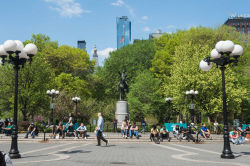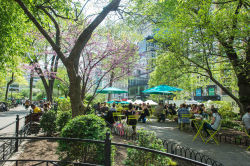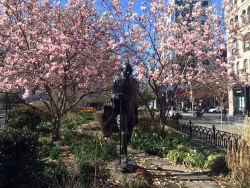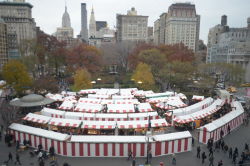Union Square Park
The Daily Plant : Tuesday, July 11, 2006
Happy 150th Birthday To Public Art In The Parks
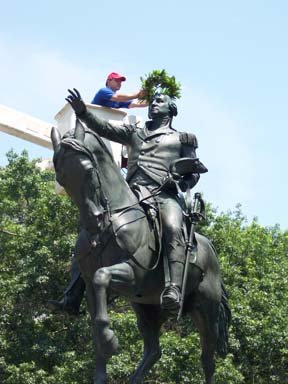
photo by Jonathan Kuhn
This past Independence Day marked an important milestone in the history of art in the parks. It was the sesquicentennial (150th anniversary) of the George Washington sculpture in Union Square Park, the oldest extant sculpture installed in any New York City park.
The heroically sized bronze equestrian statue is an early work by sculptor Henry Kirke Brown (1814-1886), who was assisted at his studio in Brooklyn by later eminent sculptor John Quincy Adams Ward. Brown also crafted sculptures of President Abraham Lincoln in Union Square and Prospect Park, while Ward was later responsible for eight sculptures in our parks, including four in Central Park. The statue, cast at the Ames Foundry of Chicopee, Massachusetts, was the second largest casting made in the United States. The elaborate pedestal of Quincy granite was designed by Richard Upjohn, the architect of Trinity Church.
The sculpture was commissioned through a popular subscription campaign under the auspices of the Washington Monument Committee. Of the $50,000 raised, $34,000 was from 68 prominent businessmen and merchants in the vicinity of Union Square, each of whom contributed $500. Other local businesses contributed labor and materials to build the foundation and deliver materials to the site. The gift of the sculpture set the model in New York City for monuments and public art in our parks originating through citizen action and private fundraising.
The sculpture was officially unveiled before thousands of jubilant spectators on July 4, 1856 at the southeast triangle at the union of Broadway and the Bowery (4th Avenue). In attendance on that day were numerous dignitaries, including Mayor Fernando Wood and State Senator Hamilton Fish.
Brown’s portrait of Washington was inspired by Houdon’s famous sculpture of Washington in 1795 (itself modeled after a death mask). The equestrian portrait of Washington represents the moment of Washington’s triumphal return to New York City on November 25, 1783 and the British evacuation. Brown combines a classical pose evoking precedents such as the Roman Marcus Aurelius, with a naturalism that was said to mark a new moment in American art. The Reverend George W. Bethune, keynote speaker at the unveiling commented, "The work is done. Genius, native genius, has nobly achieved the highest duty patriotism could demand of art."
During the renovation of Union Square Park in 1929-30, the sculpture was relocated to its more central and prominent location. This further enhanced its position as an iconic touchstone for New Yorkers, who in all manner and generations have congregated at this spot for the purpose of public assembly and expression. After the attacks of September 11, 2001, thousands again gathered here, this time to mourn.
In 1988, the sculpture was conserved through the Adopt-A-Monument Program and, in 2004, Parks’ Citywide Monuments Conservation Program again conserved the sculpture. Earlier this year program conservators installed a granite "dutchman" repair in the pedestal, replacing a long-missing piece.
This is the tenth season of the Citywide Monuments Conservation Program, a conservation and training program which provides year-round care to preserve art and monuments throughout the parks system. This year’s major supporters include the History Channel, the Samuel H. Kress Foundation, the Karan-Weiss Foundation, the David Schwartz Foundation, the American Battle Monuments Commission and the Italian Historical Society in America.
Since the erection of the Washington sculpture, the Parks collection has grown to 1,100 art and monument sites, including 300 major sculptures. More recent examples of commemorative art have included tributes to author Ralph Ellison, composer Antonin Dvorak, and humanitarians Mahatma Gandhi, Benito Juarez and Eleanor Roosevelt. The variety of styles and subject matter has diversified. From Tony Rosenthal’s geometic Cube (Alamo) in Astor Place to Rafael Ferrer’s expressionistic Puerto Rican Sun at Fox Street in the South Bronx, to George Segal’s Gay Liberation at Sheridan Square, our permanent outdoor art has reflected evolving aesthetics and social change.
On July 3, 2006, Parks marked the 150th anniversary of the George Washington sculpture with a celebration that included Commissioner Adrian Benepe, elevated in a forestry bucket-lift, placing a laurel wreath on the head of Washington. It also featured a display of historic flags created by children in the Afterschool program of the J. Hood Wright Recreation Center in Washington Heights. The crowd was treated to a medley of patriotic songs by the New York University pep band, and a rousing rendition of the National Anthem by Parks’ own Jackie Rowe-Adams. Special thanks is extended to the staff of the Manhattan Borough Office and Art & Antiquities for organizing the event.
Written by Jonathan Kuhn
QUOTATION OF THE DAY
"Not intending to anticipate the critical opinions which will be showered upon Mr. Brown’s work we may say that it’s a great ornament to the finest portion of the Empire City and that its general effect is highly impressive. It is we hope the commencement of the good work of beautifying our great metropolis, the people of which are fond of art and willing to encourage it."
Check out your park's Vital Signs
Clean & Safe
Green & Resilient
Empowered & Engaged Users
Share your feedback or learn more about how this park is part of a
Vital Park System

